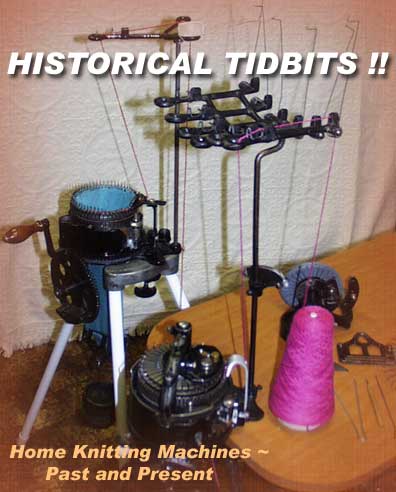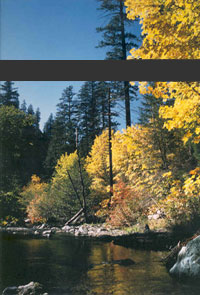Knitting History From Hand Knitting to Knitting Machines
by Sharon Nani
Hand Knitting Evolves Into Knitting With Tools
The study of museum artifacts with today's technology leads to very interesting finds. A primitive had knitting technique dating back into prehistoric times was reproduced using one needle and short pieces of fiber in a study by Dorothy Burnham in the Royal Ontario Museum in early 1970's. The next documentation speaks of three pieces of hand knitting found at the site of the old Syrian City of Dura Europos, which was sacked by the Persians in 256 AD. Study of these items defined them as having been hand knit with two knitting needles. Evolution has been and is ongoing from handknitting with one to two needles and onward to peg frames, knitting frames, circular sock machines, and home knitting machines. Just to spur your interest, I will give you a few tidbits of information from each stage.
Peg Frame ~ About 1390
A remarkable painting by a German Master Bertram (c 1390) is known as the Knitting Madonna. The painting shows Mary, mother of Jesus, knitting for her Son a seamless garment in the round on four needles. At the time of the writing of Kathleen Kinder's book: "A Resource Book for Machine Knitters," where she tells of her historical research (see footnote) this painting was at the Art Gallery in Hamburg. During the period around 1390, it was said that gloves were knitted for "the holies of holies" for the elements in the Mass and the humblest of peasants used the peg frames to knit their caps.
Stocking Loom ~ 1589
Knitted stockings became high fashion in the 16th century. Wishing to please Elizabeth I, Rev William Lee, of Calveron, Nottingham, designed his stocking frame to produce fine silk stockings. This Stocking Frame did not impress the Queen. It is said that she was much to distracted with their Armada victory to take notice of Rev Lee's invention. Hand knitters opposed the idea of knitting frames, therefore, framework knitting evolved very quietly for the next century.
Framework Knitting Evolves ~ 1730-1798
This century brought forth such evolution of what we would call "accessories" for our modern day home knitting machines. Notes credit Louis XIV of France for coming up with the "tucking bar." Two color "tuck tops for stockings" were quite popular during this period. See our honeycomb cotton baby blankets for an example of "tuck" stitches.
In 1759, Jedediah Strutt of Derby and Belper patented the "Derby rib frame." This would have been the first conversion from a single bed to a double bed frame and started a great period of inspiration for development for the knitting frames. Samuel Betts combined the tuck pressor with this rib frame to develop his tickler bar. The tickler bar actually removed and transferred stitches to make "holes." Sounds like our "lace carriages" of today. Lace is has been and is a popular fabric.
Around 1768, brocaded waistcoats became fashionable. To meet the need, Crain & Porter came up with our first "color changer." I love the story of how strings were attached to needles and "draw boys" (yes, real boys) were instructed to draw back manually selected needles by means of these strings to create the two color work! From there the punch card system of selecting patterns was developed in 1798 by Joseph Marie Jacquard. At first, due to the popularity of lace, this accessory was used for lace fabric then developed into the multi color work. All the graphics from our Native American knit blankets, caps, headbands, and scarf accessories are "double bed jacquard" fabric. The back side of the design actually knits in the different colors to eliminate the "floating" strands of yarn that you see in single bed fair isle fabric.
The Lamb Knitting Machine ~ 1867
Mr. Lamb of Northville invented the first domestic machine around 1867. It was said to have 84 needles and weigh about 15 lbs. Click here to See a picture of the copy of the front page of the old manual which I have to see what the Lamb Knitting Machine looked like. This manual states its availability as: "Class 1 – 96 needles, 6 to the inch: price $45., Class 2 -110 needles, 7 to the inch: $50, Machine Stand, with Japanned Iron Legs, Polished Black Walnut Top and Drawer, extra in all cases: $6.00."
The Crane Knitter ~ Flat Bed and Circular Sock Machines ~ 1870
The Reference in Cassell's Household Guide of 1870 advertised the Crane Knitter as a striking new American invention: "It had a massive metal plate keyboard in which deep, square grooves for the reception of 106 needles are cut, and "asort" of metal carriage or traveler, which can be moved forward or back on the keyboard with the greatest facility by the aid of a short ball-crowned handle." This was one of several sock knitting machines of that era, which included both flat and circular sock machines.
I am proud to say that I have two circular sock machines at The Knit Tree which have been restored. Occasionally, I have the opportunity to knit a special pair of socks from these sock machines for the One of a Kind category of our online catalog. Go see if a pair is there, now.
My Anslie and Legare are pictured at the beginning of this article (c late 1800's) When I found the Anslie machine, (in the attic of one of my students) it still had a "Work Sock" hanging on it. The cylinder was jammed and it was inoperable. With a loving restoration, this sock knitter was brought back to life. A box of labels "Bundles for Britain" and the hand written pattern used for these socks which were knit for our soldiers during the war, were also in the wooden carrying box. This is the same instruction pattern, I follow for the socks offered in The Knit Tree's One of a Kind Showroom – making these socks a special treat!
Today’s Home Knitting Machines ~ 1908 – Present
Little is known about the New Harrison "Plain and Purl" knitting machine of 1908. Japan claims Masako Hagiwara invented the first hand knitting machine for the home in 1924. It required that the yarn was laid across the needles by hand. Then we come to the first European domestic machine, a Passap, shown in Zurich, Switzerland in 1939 – we have come along way since then.
Now, we have knitting machines ranging from manual, entry level machines - to punch card -to electronic home knitting machines. Each is fascinating in their unique way and each offers different ways of creating fabrics. There are machines from fine gauge - to standard - to bulky. Each with different size latch needles for creating different weights and kinds of fabric. But one thing most of the domestic knitting machines have in common is that they can all do the basic types of stitch construction: knit, tuck, and slip fabrics. The thing that makes them different is the speed and ease with which they do it!
The Knit Tree Offers Instruction and Creative Knit Items
Sharon Nani has representative knitting machines available from each category from the late 1800 circular sock machines to modern day electronic home knitting machines at her Knit Tree studio. Each is used for demonstration and private instruction – by appointment only - and for creating products for our Online Distinctive and Original Knitwear. Visit our Online Store to see the possibilities.
Credit is given to Kathleen Kinder author of the book " A Resource Book for Machine Knitters," Published in February 1979 in England. Much of the information in this article can be found in much greater detail within her book.
Other sources of information can be found at:
"The Hand- Cranked Knitter and Sock Machine" by Richard Candee is the best resource book on the history of hand or treadle powered knitting machines invented in the United States and manufactured in North Amrica from 1813 to the 1990's. that I have seen. Anyone interested in the history of knitting machines would enjoy this resource book!>
Antique Sock Knitting Machine Internet Museum http://www.victiques.com/Knit_Museum/Amuseum.htm
Distinctive Knits US Importer of Artisan Home Knitting Machines
Knit Craft Silver Reed Home Knitting Machines



